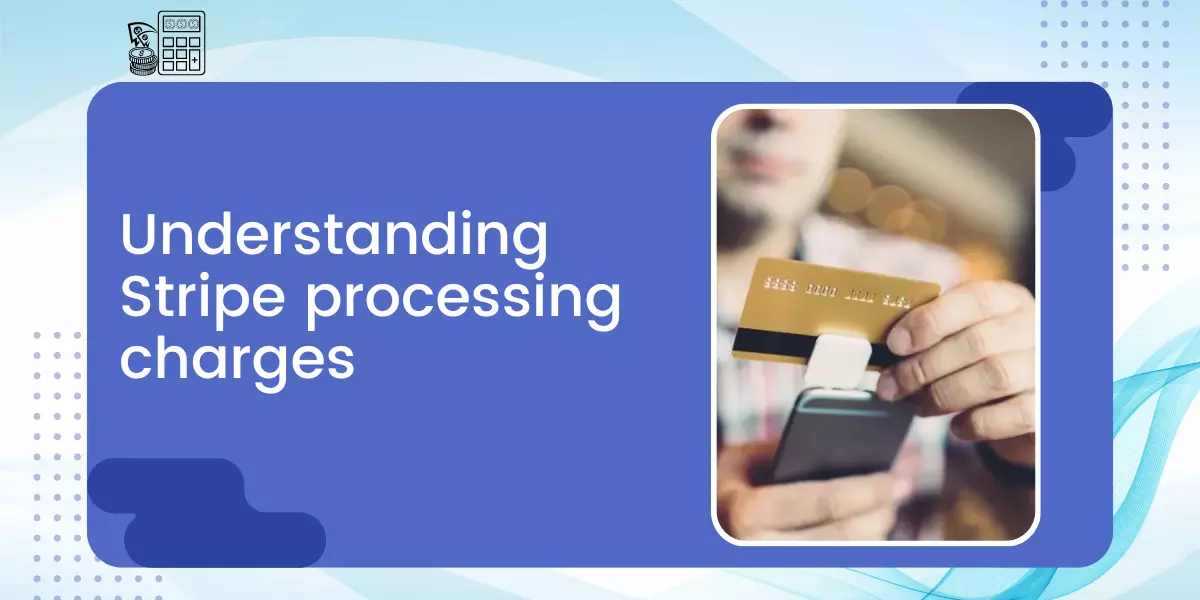In an era where online transactions have become the norm, businesses of all sizes increasingly rely on efficient payment processing solutions. As the demand for seamless transactions grows, understanding the charges associated with payment processing becomes paramount. This is where Stripe, a leading payment gateway, comes into play.
Stripe has become a preferred choice for businesses seeking reliable and flexible payment processing services. With its user-friendly interface and robust features, Stripe offers a seamless experience for businesses and customers. However, navigating the various processing charges can be daunting without proper guidance.
That’s where our Stripe Fee Calculator tool comes in handy. Designed to provide clarity and transparency, our tool helps businesses accurately estimate processing costs, empowering them to make informed decisions. Whether you’re a small startup or a large enterprise, understanding and managing processing charges is essential for optimising your financial operations.
Join us as we delve into the intricacies of Stripe processing charges, exploring the different fee structures, potential cost-saving strategies, and everything else you need to know to streamline your payment processing experience. Let’s embark on this journey together to unlock the full potential of your business’s online transactions.
Demystifying Stripe Processing Charges
Demystifying Stripe Processing Charges: Understand the intricacies of Stripe’s fee structures and optimise your payment processing. Our guide breaks down the complexities, clarifying transaction fees, currency conversions, and more. Gain insights to streamline your financial operations and maximize efficiency.
Core Transaction Fees – The Foundation
The core of Stripe’s transaction fees lies in its simple yet essential structure: a combination of a percentage fee and a per-transaction charge. The percentage fee typically stands at 2.9%, a standard rate applied to the total transaction amount. In addition to this percentage, there’s a fixed per-transaction charge, commonly set at 30 cents. This dual approach ensures that Stripe covers its operational costs while offering a transparent pricing model to its users.
This fundamental structure allows businesses to accurately predict payment processing costs. Whether handling small or large transactions, combining a percentage fee and a fixed charge ensures that businesses pay proportionally to their transaction volume. Moreover, the simplicity of this model makes it easier for businesses of all sizes to understand and budget for their payment processing expenses.
Understanding these core transaction fees is essential for businesses aiming to optimise their financial operations. By grasping the foundational elements of Stripe’s pricing model, businesses can make informed decisions about their payment processing strategies, ensuring efficiency and cost-effectiveness in their operations.
Beyond the Fees: Additional Cost Considerations
In addition to the core transaction fees, businesses utilising Stripe must consider several additional cost factors that can impact their overall expenses. While not as prominent as the transaction fees, these supplementary charges are crucial in determining the total cost of using Stripe’s services.
1. Integration Costs
When considering integrating Stripe with your platform, it’s essential to factor in potential costs associated with the integration process. These costs may vary depending on the complexity of your platform and the extent of integration required. Businesses may incur development fees if they choose to build a custom integration tailored to their specific needs. Alternatively, they might opt for pre-built solutions or plugins offered by third-party developers, which may involve monthly subscription charges or one-time fees.
Additionally, businesses should consider the time and resources required to integrate Stripe seamlessly into their existing infrastructure, including testing and troubleshooting to ensure compatibility and functionality. By assessing these integration costs upfront, businesses can budget accordingly and choose the most cost-effective approach to integrate Stripe into their platform.
2. PCI Compliance Costs
PCI compliance is crucial for payment gateways to ensure cardholder data security and protect against data breaches. Non-compliance can result in hefty fines, legal liabilities, and damage to reputation. Achieving and maintaining PCI compliance involves various costs, including audits and certifications. These costs can vary depending on factors such as the size of the business, the complexity of its payment processing systems, and the level of compliance required.
Audits may incur fees from qualified security assessors (QSAs) who assess the organisation’s compliance status and provide recommendations for improvement. Certification costs involve obtaining formal compliance validation from the Payment Card Industry Security Standards Council (PCI SSC). While these costs may seem burdensome, they are essential investments in safeguarding sensitive payment data and maintaining customer trust. By prioritising PCI compliance and allocating resources accordingly, businesses can mitigate the risk of data breaches and protect their reputation in an increasingly digital marketplace.
1. Understanding Stripe’s Fee Structure
In understanding Stripe’s fee structure, it’s essential to grasp the intricacies of how the platform charges for its services. Stripe’s transparent fee system comprises various components: transaction fees, integration costs, and compliance expenses. By comprehensively examining these elements, businesses can gain insight into their payment processing costs and make informed decisions to optimise their financial strategies. Let’s delve into the details of Stripe’s fee structure to uncover how it impacts businesses and explore ways to navigate the complexities of payment processing on the platform.
2. Volume Discounts & Cost Optimization
Processing larger volumes with Stripe can lead to significant cost savings through volume discounts. As businesses scale up their operations and process higher transaction volumes, they become eligible for reduced transaction fees per payment. Stripe offers customised pricing models for businesses with substantial transaction volumes, allowing them to negotiate lower fees based on their processing volume. By leveraging these volume discounts, businesses can optimise their payment processing costs and improve their bottom line. This incentivises growth and encourages businesses to expand their operations while benefiting from more competitive pricing structures. Additionally, optimising transaction volumes ensures businesses maximise their efficiency and profitability within the Stripe ecosystem.
3. Card Network Fees – A Transparent View
While Stripe doesn’t have control over card network fees, it’s important to understand that these fees are a component of the overall transaction cost. Card network fees are charged by major credit card companies like Visa, Mastercard, and American Express for using their payment networks. When processing payments through Stripe, these card network fees are passed on to the merchant and are included in the total transaction cost. While Stripe strives to maintain transparency regarding these fees, merchants should be aware that fluctuations in card network fees can impact their overall processing costs. Understanding these fees helps businesses make informed decisions regarding their payment processing strategies and cost management.
Managing Your Stripe Processing Charges
Managing your Stripe processing charges involves several key steps to optimise costs and ensure efficiency. This includes regularly monitoring transaction volumes, exploring volume discounts offered by Stripe, and implementing strategies to mitigate chargeback risks. Additionally, businesses can leverage tools like the Stripe Fee Calculator to estimate costs accurately and make informed decisions. By staying informed about Stripe’s fee structure, actively managing transaction volumes, and utilising available resources, businesses can effectively manage their processing charges and maximise their overall profitability.
1. Optimizing Your Payment Flow
Optimising your payment flow is essential for reducing processing charges and maximising cost efficiency. One effective strategy is to encourage using ACH transfers, especially for transactions with lower fees than credit card payments. This can be achieved by offering incentives or promoting the benefits of ACH transfers to customers. Additionally, implementing automated recurring billing for subscription services can help streamline payment processing and reduce the frequency of individual transactions, ultimately lowering overall processing costs.
Furthermore, businesses can explore options for consolidating transactions or batching payments to minimise the number of transactions processed, thereby reducing associated fees. Leveraging advanced fraud prevention tools provided by Stripe can also help mitigate the risk of chargebacks and fraudulent transactions, ultimately reducing potential losses and associated dispute fees.
Regularly reviewing and optimising your payment flow, coupled with proactive measures to incentivise cost-effective payment methods and minimise transaction volumes, can significantly contribute to optimizing your processing charges and bottom line. By implementing these strategies, businesses can effectively manage their payment processing costs while ensuring a seamless and efficient payment experience for their customers.
2. Choosing the Right Payment Methods
When choosing the right payment methods, it’s crucial to consider alternatives that could potentially offer lower fees for specific transactions. One such alternative is ACH transfers, which can be particularly beneficial for businesses processing high volumes of transactions or dealing with larger transaction amounts. ACH transfers typically incur lower fees than traditional credit card payments, making them an attractive option for reducing processing costs.
Additionally, ACH transfers are advantageous for recurring payments, such as subscription services, as they often involve lower transaction fees and offer greater flexibility in payment schedules. By incorporating ACH transfers into your payment methods, you can provide customers with a cost-effective payment option while also optimising your processing charges.
However, assessing your customer base’s specific needs and preferences is essential when selecting payment methods. While ACH transfers may offer lower fees in certain situations, they may not be suitable for all customers or transaction types. Therefore, it’s essential to offer diverse payment options to accommodate varying preferences and ensure a seamless payment experience for all customers. By carefully choosing the right payment methods for your business, you can effectively reduce processing charges and optimise your overall payment processing strategy.
Conclusion
In conclusion, understanding Stripe processing charges is essential for businesses aiming to optimise their payment processing strategies effectively. Throughout this discussion, we’ve explored various aspects of Stripe’s fee structure, including core transaction fees, integration costs, PCI compliance, volume discounts, and card network fees. By grasping these components, businesses can make informed decisions about their payment processing methods and manage their costs efficiently.
Furthermore, we’ve highlighted the importance of optimizing payment flows and choosing the right payment methods to reduce processing charges potentially. Strategies such as encouraging ACH transfers and considering alternative payment methods can help businesses minimise fees and enhance their bottom line.
Ultimately, while processing charges are an inevitable aspect of payment processing, businesses can leverage Stripe’s transparent fee structure and flexibility. By understanding the nuances of Stripe processing charges and implementing cost-saving strategies, businesses can streamline their payment operations, improve their financial health, and provide an optimal payment experience for their customers.
With the right approach to managing Stripe processing charges, businesses can achieve greater cost efficiency, scalability, and competitiveness in the increasingly digital marketplace. It’s crucial for businesses to continually evaluate their payment processing strategies, stay informed about industry trends, and adapt to evolving customer preferences to maintain a competitive edge in the market.
FAQ’s
What is the Stripe processing fee?
The Stripe processing fee typically consists of a percentage fee (e.g., 2.9%) and a fixed fee per transaction (e.g., $0.30), varying depending on transaction volume and card type factors.
What are the total fees for Stripe?
The total fees for Stripe include transaction fees, potential additional charges for services like currency conversion or refunds, and any applicable taxes or regulatory fees.
Is Stripe cheaper than PayPal?
Comparing Stripe and PayPal fees depends on various factors such as transaction volume, currency, and card type. Generally, Stripe may offer lower fees for certain transactions, but the suitability varies based on business needs.
What is charged in Stripe?
In Stripe, charges typically refer to the fees incurred for processing payments, including the percentage and fixed fees per transaction.
What is the $1 charge on Stripe?
The $1 charge on Stripe might be a test transaction or an authorization hold to verify a payment method commonly used for authentication or validation purposes.
Can Indians use Stripe?
Yes, Indians can use Stripe for online payment processing, subject to compliance with Stripe’s terms and conditions and any applicable regulatory requirements.
Which is better, Razorpay or Stripe?
Choosing between Razorpay and Stripe depends on transaction volume, business requirements, and pricing structure preferences. Both platforms offer distinct features and advantages.
Is Stripe payment free?
Stripe charges fees for processing payments, including a percentage of the transaction amount and a fixed fee per transaction. There may also be additional charges for particular services or features.
Can I reduce Stripe fees?
Businesses can explore strategies to reduce Stripe fees, such as optimizing payment flows, encouraging lower-cost payment methods, and negotiating volume discounts with Stripe.
Does Stripe have UPI?
Stripe does not directly support UPI (Unified Payments Interface) transactions, but businesses can integrate third-party services or platforms that support UPI payments with Stripe.
Are Stripe fees GST-free?
Depending on the jurisdiction and regulatory requirements, stripe fees may be subject to Goods and Services Tax (GST) or other applicable taxes.
Who is Stripe’s biggest competitor?
Stripe faces competition from various payment processing companies, including PayPal, Square, Adyen, and Braintree, depending on the market and industry.
Does Stripe refund fees?
Stripe may refund fees under certain circumstances, such as chargebacks or refunds initiated by merchants. However, the specific refund policies and procedures may vary.
Why is Stripe better than PayPal?
Stripe and PayPal offer different features and benefits, and the preference between the two depends on factors such as ease of use, pricing structure, integration options, and customer support.
What is the limit of Stripe processing?
Stripe typically does not impose specific limits on transaction processing, but businesses may encounter account restrictions or additional verification requirements based on transaction volume, risk factors, or regulatory compliance.










